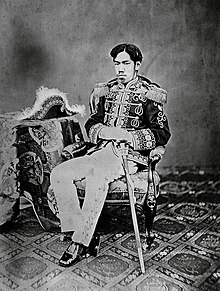 |
| The Meiji Emperor |
According to the oldest Japanese books “Kojiki”, or 古事記, the “Chronicles of Japan”, or 日本書紀, Japanese imperial system began in B.C 660. Following after the first emperor Jimmu, the present emperor is 125th in the history of the imperial family. In Japanese history the position of the emperor has been always changed because of temporary rulers. That is, it cannot be right things to regard emperor as strongest power in this country. This essay will focus on the status of Meiji emperor by comparing with present emperor. In order to examine the difference between Meiji emperor and present emperor, this essay will look over the status of these two emperors and compare these two men.
Firstly, how much power did the Meiji emperor have? According to Sasaki, an emeritus professor at University of Kyoto, Meiji emperor was trained when he was young by Meiji government not to interfere in political march for modernization, the Meiji restoration. This was because the former emperor Koumei, father of Meiji emperor, sometimes showed his political opinion (Sasaki, 2005). Compared with Koumei, the political presence of Meiji emperor was very limited. However, this did not mean he did not do any political activity. Sasaki mentions that the Meiji emperor was used by Meiji government to promote unification for new Japan. It is obvious that Koumei had physical power on Japanese politics even though he had appeared in public just twice, but the portrait of Meiji emperor was widely distributed throughout the country. This is evidence that Meiji emperor was used politically to promote Meiji restoration without having political power.
Secondly, I will discuss the status or position of present emperor. According to the contemporary Japanese constitution article 1, “The Emperor shall be the symbol of the State and of the unity of the People, deriving his position from the will of the people with whom resides sovereign power” (Imperial Household Agency, n.d.). The constitution clearly defines the emperor as a symbol of the State and it also set a restraint of activity for the emperor. In short, similar to the Meiji emperor, the present emperor has no power to remark politically.
Thirdly, let us compare Meiji emperor with present emperor. As this essay has examined in second and third paragraphs, there are some similarities between two emperors. Firstly, both emperors have/ had no power politically. The Meiji emperor had no power to make decisions but he was literally final decision maker. It can be said that Meiji emperor was used just like as a symbol of the new Japan, new government and new country. Secondly, as a symbol of the State both emperors often appear in front of the nation. This emperor’s activity is sometimes used for political reasons, so although the emperor has no political power in present constitution spiritually Japanese people still pay great sense of respect for the emperor.
In conclusion, Japanese emperor has been sort of symbol of the State even in the Meiji era when the constitution defined that the emperor had sovereignty. As a result of that, there are no particular differences between Meiji emperor and present emperor in terms of their being the symbol of the State.
References
Sasaki, S. (2005). Bakumatsu no Tennou・Meiji no Tennou. [The Emperor at the End of Shogunate Government and Meiji Era]. Tokyo: Koudansha.
Imperial Household Agency. (n.d.). Tennou. [The Emperor]. Retrieved July 25, 2013, from Imperial Household Agency web site: http://www.kunaicho.go.jp/about/seido/seido01.html#H2-01
Takeda, T. (2011). Kojiki. [Kojiki]. Tokyo, Gakken.
